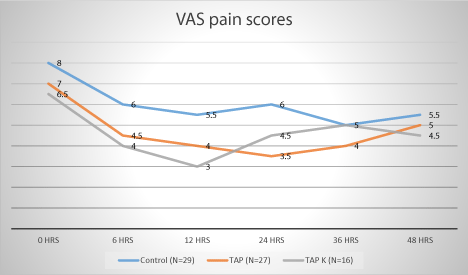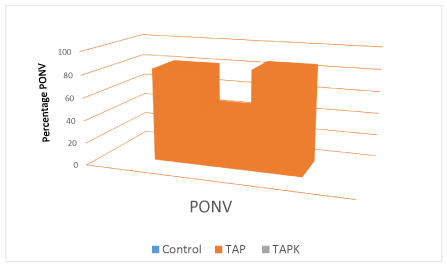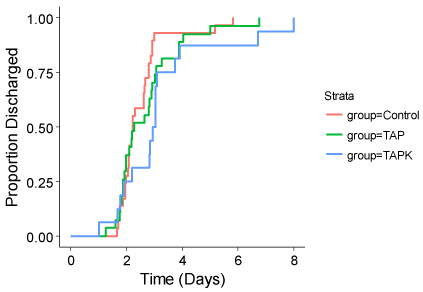A Retrospective Analysis of the Effects of Transversus Abdominis Plane Blocks With and Without Analgesic Ketamine in Multimodal Analgesia Regimens for Total Abdominal Hysterectomy Surgery?
Mark Stevens*, Sarah K Tingle and Greg Mehaffey
Department of Anesthesiology, the University Of Arkansas for Medical Sciences, Little Rock, AR, USA
*Address for Correspondence: Mark Stevens, Department of Anesthesiology, the University of Arkansas for Medical Sciences, Little Rock, AR, USA, Tel: 501-686-6114; Email: grmehaffey@uams.edu / mstevens@uams.edu
Submitted: 25 October 2017; Approved: 05 December 2017; Published: 06 December 2017
Citation this article: Stevens M, Tingle SK, Mehaffey G. A Retrospective Analysis of the Effects of Transversus Abdominis Plane Blocks With and Without Analgesic Ketamine in Multimodal Analgesia Regimens for Total Abdominal Hysterectomy Surgery. Int J Pain Relief. 2017;1(1): 026-030.
Copyright: © 2017 Stevens M, et al. This is an open access article distributed under the Creative Commons Attribution License, which permits unrestricted use, distribution, and reproduction in any medium, provided the original work is properly cited
Download Fulltext PDF
Background: The efficacy of Transversus Abdominis Plane (TAP) blocks in reducing postoperative narcotic consumption has been established, but the impact of TAP blocks in a multimodal analgesic regimen have been studied to a lesser degree. This study aims to evaluate the efficacy of TAP blocks following Total Abdominal Hysterectomy (TAH) surgery in two different multimodal analgesic regimens.
Methods: After local institutional review board approval (#204508), all adult women that underwent TAH surgery at our institution between May 1, 2014 and June 30, 2016 were assigned one of three groups dependent upon the analgesic regimen used to address postoperative pain. Group 1 (Control) patients received NSAIDS, acetaminophen, and narcotics for intraoperative and postoperative analgesia. Group 2 (TAP) received NSAIDS, acetaminophen, narcotics, and an intraoperative TAP block. Group 3 (TAPK) received NSAIDS, acetaminophen, narcotics, an intraoperative TAP, and an intraoperative dose of ketamine. Cumulative opioid consumption, NRS pain scores, PONV rates, and length of stay were recorded for 48 hours postoperatively and compared.
Results: The intervention groups, (TAP n = 33, TAPK n = 16) and the control group (n = 29) were comparable with respect to patient characteristics. The TAP group's median cumulative morphine usage (38.3 mg [IQR = 29-54]) and TAPK’s median cumulative morphine usage (37.5 mg [IQR = 26-66]) at 24 hours were significantly less than that of the control group (77.5 mg [IQR = 46-97]). The TAP and TAPK groups showed reduction in NRS pain scores at various times compared to the control group. The TAP group demonstrated a significant reduction in PONV compared to the control and TAPK groups, and median Length Of Stay (LOS) were similar between the two groups.
Conclusion: TAP blocks with and without the addition of intravenous ketamine in patients undergoing TAH reduced opioid consumption in the first postoperative day
Introduction
Postoperative pain must be addressed in every patient that undergoes a surgical procedure, but that comes with a cost when we use the most common perioperative analgesic, narcotics. Adverse Drug Events (ADEs) attributed to narcotic administration include Postoperative Nausea and Vomiting (PONV), delayed return of bowel function, sedation, respiratory depression, urinary retention, and immune system suppression[1]. A single ADE from narcotics can lengthen hospital stay by 3 days and thus add approximately $4,700 to the cost of care for a surgical encounter [2]. Multimodal postoperative analgesic regimens are gaining popularity in an effort to minimize narcotic usage and thus the ADEs related to them.
Regional anesthesia techniques provide superior analgesia compared to narcotics, while limiting serious ADEs [3]. Transversus Abdominis Plane (TAP) blocks have gained popularity in abdominal and pelvic procedures in order to optimize recovery. First described in 2001 by Rafi, TAP blocks were reported to provide analgesia to the anterolateral abdominal wall [4], and with the introduction of ultrasound guidance, this procedure has become technically simple with a high margin of safety. The aim of this retrospective cohort study was to analyze the reduction in postoperative narcotic consumption attributed to the addition of TAP blocks to a multimodal analgesia regimen consisting of perioperative Nonsteroidal Anti-Inflammatory Drugs (NSAID) and narcotics for patients undergoing Total Abdominal Hysterectomy (TAH) surgery. This study also includes a third arm that adds a single intraoperative dose of intravenous ketamine to the analgesic regimen and reports if any reduction in postoperative narcotic consumption is seen.
Methods
This study was approved by the institutional review board, reference no. 204508, and dated August 2, 2016. The perioperative medical record of all women 18 years and older who underwent TAH with salpingo-oophorectomy at the University of Arkansas for Medical Sciences between May 1, 2014 to June 30, 2016 who did not have a history of chronic narcotic use preoperatively and were ASA physical status 1-3 at the time of surgery were included. Patients who had allergies to NSAIDS or who received adjunct analgesic agents other than those included in the study were excluded. In total, 264 cases were identified. Of those, exclusions occurred due to ASA > 3, lack of intraoperative or postoperative NSAID administration, addition of analgesics other than those included in the study such as dexamethasone, and lack of TAP block or TAP block performed at times after emergence from anesthesia.
The charts for all patients who met the above criteria were reviewed and patients were assigned to three groups. Group 1 (Control group) patients received NSAIDS, acetaminophen, and narcotics for intraoperative and postoperative analgesia. Group 2 (TAP group) patients received NSAIDS, acetaminophen, narcotics, and an intraoperative TAP block. Group 3 (TAPK group) patients received NSAIDS, acetaminophen, narcotics, an intraoperative TAP block as in Group 2, plus an intraoperative analgesic dose of ketamine (0.5-1 mg/kg at induction of anesthesia). The dosages of NSAIDS and acetaminophen were equivalent across the groups.
General anesthesia for each case consisted of induction with fentanyl 1-1.5 µg/kg followed by propofol 1.5-2 mg/kg. Patients then received either succinylcholine 1.5-2 mg/kg or rocuronium 0.6-1.2 mg/kg to facilitate tracheal intubation, followed by rocuronium or cisatracurium to provide surgical conditions. The TAP blocks were performed under ultrasound-guidance at the conclusion of the surgical procedure but prior to emergence and extubation. Blocks were performed with a 20g echogenic needle (Halyard Health, echobright nonstim needle, 100mm) to deliver 40cc of 0.25% bupivacaine, 20cc per side. First, the skin on each side was prepped with chlorhexidine at the midaxillary line between the iliac crest and inferior costal margin, and a linear high-frequency probe was used to visualize the three lateral abdominal wall muscles. The block needle was inserted under aseptic technique, and advanced using in-plane ultrasound visualization until the needle tip was confirmed between the transversus abdominis and internal oblique muscles, at which point 20cc of 0.25% bupivacaine was injected in incremental doses. Anesthesia was maintained with oxygen, air, and sevoflurane or isoflurane.
The primary outcome of analysis was the total dose of morphine equivalents consumed in the 24 hours after surgery. All narcotics consumed by the patients were converted into intravenous morphine-dosage equivalents using the calculator at http://www.medcalc.com/narcotics.html. Secondary outcomes included pain assessment using an 11-point Numeric Rating Scale (NRS) at postoperative time of 0, 6, 12, 24, 36, and 48 hours, postoperative Length of Stay (LOS), and the presence PONV. PONV was defined as the need for administration of the rescue anti-emetics ondansetron or promethazine.
Statistical Analysis
Data are summarized using medians and inter-quartile ranges for variables that are continuous or ordinal, while percentages and counts were used to summarize categorical and dichotomous variables. We hypothesized that a 30% decrease in opioid consumption would be clinically meaningful. Average morphine consumption for the first 24 hours after TAH was obtained from previously published data [5-7].
Wilcoxon rank-sum tests were used to compare the control group to TAP and TAPK groups with respect to the amount of post-operative narcotics used, and NRS pain scores. The distributions of time-to-discharge (LOS) for each group were estimated using the methods of Kaplan and Meier and these distributions were compared using log-rank tests. Finally, logistic regression models were used to analyze dichotomous outcomes, e.g. incidence of PONV. A 5% α-level was used to determine statistical significance.
Results
During the period of May 2014 to June 2016, 244 women underwent TAH with or without salpingo-oophorectomy at our institution. Of those, 172 patients were excluded due to lack of administration of perioperative NSAIDS, administration of analgesics other than those in the protocol, or for TAP blocks performed at times after the emergence from anesthesia. The groups were comparable in respect to height, weight, age, ASA physical status, and duration of procedure (Table 1). The TAP group had a 50% reduction in 24-hour narcotic consumption compared to the Control group, and the TAPK group had a 52% reduction in narcotic consumption at 24 hours as compared to the Control group. There was no significant decrease in narcotic consumption in the TAP and TAPK groups compared with the Control group between 24 and 48 hours postoperatively (Table 2).
In examining postoperative NRS pain scores, the TAP group showed a reduction in values versus the Control group at 6, 12, 24, and 48 hours postoperatively. The TAPK group only showed a significant reduction in VAS scores as compared to the Control group at 12 hours (Table 3).
The incidence of PONV during postoperative hospital admission was reduced in the TAP group by 42% as compared to the control group. The TAPK group showed a PONV incidence similar to the control group, however the data did not achieve statistical significance (Table 4). Postoperative hospital Length of Stay (LOS) was similar between all groups, with the TAPK group actually showing a slightly longer LOS than the other groups, with LOS between 2 and 3 days (Table 5).
Discussion
The use of TAP blocks for postoperative analgesia following abdominal surgery, and in particular following TAH surgery, have mostly been performed in the setting of an otherwise narcotic-based postoperative analgesic regimen [8]. TAP blocks differ from neuraxial techniques in that they provide somatic analgesia only, which depending on the degree of visceral pain following certain procedure types, makes a setting of multimodal analgesia important. At our institution we are experienced with multimodal analgesia due to years spent practicing enhanced recovery techniques for other intra-abdominal surgery types like colorectal, and we have enjoyed great success with these regimens and seen hospital length of stays decrease dramatically. Therefore we wanted to evaluate two things with this study: the reduction in postoperative narcotic consumption and PONV attributed to the addition of TAP blocks to our narcotic and NSAID-based intraoperative and postoperative analgesic regimen for TAH surgery, and if any added benefit was obtained by adding a single intraoperative analgesic dose of ketamine to that regimen. The analgesic benefits of ketamine, both as a single intraoperative bolus and as a postoperative infusion, have been studied extensively and have been shown to reduce postoperative narcotic consumption by 30-40% in the first 24 hours after surgery [9], but it’s effect when added to a multimodal regimen that includes regional anesthesia has not been extensively researched.
The 50% reduction in narcotic consumption at 24 hours and overall 45% reduction in narcotic consumption at 48 hours from the addition of an intraoperative TAP block was not surprising. Other studies have shown similar benefits from this regional anesthetic technique for TAH cases, both in a narcotic-only setting and in a narcotic plus NSAIDs regimen like our Control group [10]. The reduction in NRS pain scores in the TAP group as compared to the Control group at all 6, 12, 24, and 48 hours postoperatively, and the reduction in PONV by 40%, was expected as well, based on our observations of the recovery of TAP patients versus Control group patients in the recovery room.
What we did find interesting was that the addition of an intraoperative dose of intravenous ketamine did not significantly reduce the narcotic usage from the TAP group, and postoperative NRS pain scores were similar to the TAP group. This might speak to the amount of visceral pain typically experienced postoperatively by TAH patients since ketamine primarily exerts its analgesic effect on the 2nd order neuron side of the primary to secondary order neuron synapse in the dorsal column. NMDA-receptor antagonism would have less benefit if the ventral ramus of the spinal nerve was blocked from a TAP block and the visceral pain was minimal as well. Ketamine’s dramatic effect on postoperative nausea and vomiting, although not statistically significant, was unanticipated as we expected that the reduction in narcotic consumption would lead to a similar reduction in PONV as was seen in the TAP group [11].
The application of the results from this analysis is that the somatic pain control provided by TAP blocks has a profound effect on narcotic consumption and PONV postoperatively when added to a multimodal perioperative analgesic regimen of NSAIDS and narcotics, but the addition of IV ketamine to that regimen does not provide further benefit. This study was limited by the fact that it was a retrospective observational cohort study, without guidelines, for administration of narcotics and anti-emetics. Also undefined was discharge criteria, and thus our hospital LOS data is not strongly supportive in favor of the benefits of TAP blocks in reducing hospitalization duration. But, if you apply Oderda’s data mentioned previously, it would be reasonable to think that in addition to lowering PONV, TAP blocks also decrease the incidence of other ADEs attributed to narcotic consumption and thus might have an impact on length of stays and overall cost of care.
Also moving to the forefront of postoperative outcome measures is patient satisfaction, of which pain control and minimal postoperative hospitalization are major factors. The TAP group had lower pain scores, and according to Jensen et al, a VAS score of 4 or less is all that is needed for a patient to feel “very satisfied” with their postoperative pain control [12]. We have seen this measure contribute to the replacement of the previous gold standard regional anesthetic technique for postoperative analgesia following intra-abdominal surgery in our practice, epidural analgesia. Obvious are the set of risks and complications attributed to epidurals, including hypotension, infection, bleeding, postdural puncture headache, leg weakness, and urinary retention [13]. As part of the continued push to improve patient outcomes and satisfaction, shorten hospital length of stays, and reduce costs, regional anesthesia techniques away from the neuraxium are becoming more prevalent as part of a multimodal approach to pain management [14]. But as we move into more sophisticated multimodal analgesic regimens, we should continue to be mindful of the possibility for a point of diminishing returns as seen with our TAPK group. Degree of expected visceral pain following certain procedure types should factor into a clinician’s decision-making as he/she constructs a multimodal regimen that optimizes pain control and minimizes risk of complications.
- Safe Use of Opioids in Hospitals. The Joint Commission. Sentinel Event Alert. 2012; 49: 1-5. https://goo.gl/MYism2
- Oderda GM, Gan TJ, Johnson BH, Robinson SB. Effect of Opioid-Related Adverse Events on Outcomes in Selected Surgical Patients. J Pain Palliat Care Pharmacother. 2013; 27: 62-70. https://goo.gl/9w5G6a
- Walter CJ, Maxwell-Armstrong C, Pinkney TD, Conaghan PJ, Bedforth N, Gornall CB, et al. A randomised controlled trial of the efficacy of ultrasound-guided transversus abdominis plane (TAP) block in laparoscopic colorectal surgery. Surg Endosc. 2013; 27: 2366-2372. https://goo.gl/1DLbHG
- Rafi A. Abdominal field block: a new approach via the lumbar triangle. Anaesthesia. 2001; 56: 1024-1026. https://goo.gl/qLYEcu
- Durmus M, Kadir But A, Saricicek V, Ilksen Toprak H, Ozcan Ersoy M. The post-operative analgesic effects of a combination of gabapentin and paracetamol in patients undergoing abdominal hysterectomy: a randomized clinical trial. Acta Anaesthesiol Scand. 2007; 51: 299-304. https://goo.gl/Um5bnJ
- Alayed N, Alghanaim N, Tan X, Tulandi T. Preemptive Use of Gabapentin in Abdominal Hysterectomy: A Systematic Review and Meta-analysis. Obstet Gynecol. 2014; 123: 1221-1229. https://goo.gl/fh72uk
- Gilron I, Orr E, Tu D, O'Neill JP, Zamora JE, Bell AC. A placebo-controlled randomized clinical trial of perioperative administration of gabapentin, rofecoxib and their combination for spontaneous and movement-evoked pain after abdominal hysterectomy. Pain. 2005; 113: 191-200. https://goo.gl/7tXvLX
- Yu N, Long X, Lujan-Hernandez JR, Succar J, Xin X, Wang X. Transversus abdominis-plane block versus local anesthetic wound infiltration in lower abdominal surgery: a systematic review and meta-analysis of randomized controlled trials. BMC Anesthesiol. 2014; 14: 121. https://goo.gl/PpSpGw
- Jouguelet-Lacoste J, La Colla L, Schilling D, Chelly JE. The Use of Intravenous Infusion or Single Dose of Low-Dose Ketamine for Postoperative Analgesia: A Review of the Current Literature. Pain Med. 2015; 16: 383-403. https://goo.gl/7vYeYj
- Johns N, O'Neill S, Ventham NT, Barron F, Brady RR, Daniel T. Clinical effectiveness of transversus abdominis plane (TAP) block in abdominal surgery: a systematic review and meta-analysis. Colorectal Dis. 2012; 14: 635-642. https://goo.gl/ZYoz3j
- Assouline B, Tramer MR, Kreienbuhl L, Elia N. Benefit and harm of adding ketamine to an opioid in a patient-controlled analgesia device for the control of postoperative pain: systematic review and meta-analyses of randomized controlled trials with trial sequential analyses. Pain. 2016; 157: 2854-2864.
- Jensen MP, Martin SA, Cheung R. The meaning of pain relief in a clinical trial. J Pain. 2005; 6: 400-406. https://goo.gl/AQVvoP
- Rao Kadam V, Van Wijk RM, Moran JI, Miller D. Epidural versus continuous transversus abdominis plane catheter technique for postoperative analgesia after abdominal surgery. Anaesth Intensive Care. 2013; 41: 476-481. https://goo.gl/kDtu6a
- Rawal N. Epidural technique for Postoperative Pain. The Gold Standard No More? Reg Anesth Pain Med. 2012; 37: 310-307. https://goo.gl/NoUYgk




Sign up for Article Alerts